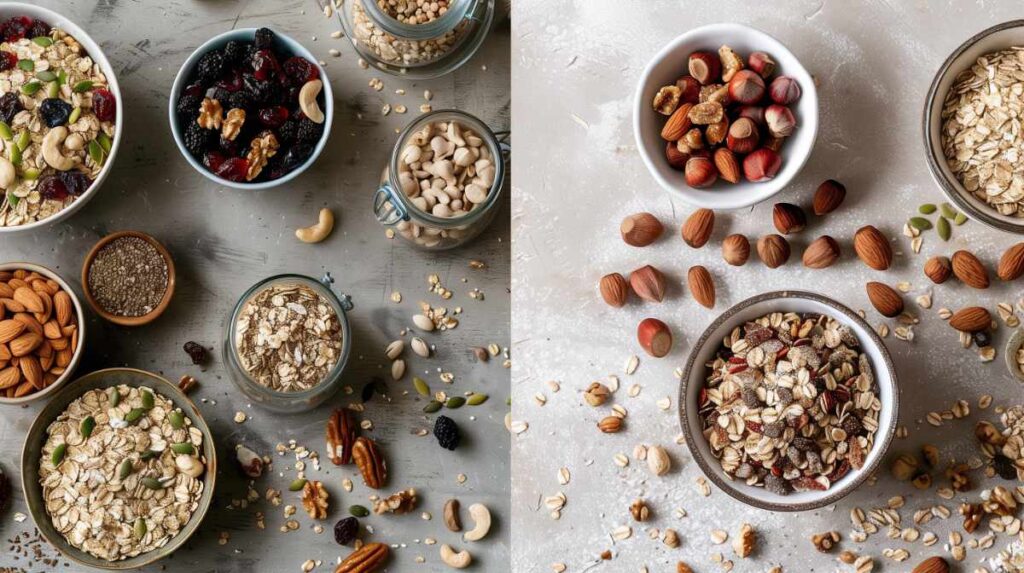
Granola vs Muesli Showdown: Which Breakfast Option Is Right for You?
Breakfast cereals are big business in Australia. According to the Australian Bureau of Statistics, almost everyone eats cereal on a regular basis. Granola and muesli are two popular options, combining flavour with a great nutritional profile. But what’s the difference and which is right for you?
We’re going to explore the benefits of both granola and muesli in this post to help you decide which option is best for you. Read on to learn facts about granola and muesli and how to serve them. Once you reach the end of this post, you’ll have a clear idea of which option is the best fit for your lifestyle.

Overview of Granola and Muesli
Let’s find out how granola and muesli compare in terms of ingredients.
Granola is made up of rolled oats, nuts and seeds plus a natural sweetener like honey or maple syrup and sometimes an oil to help bind the ingredients. These components are mixed together and then baked. The end result is delicious crunchy clusters.
It’s a versatile breakfast option — you can eat granola in a bowl with cold milk like other cereals or use it as a topping to yoghurt or fruit.
Just like granola, muesli’s core ingredients include rolled oats and nuts. It often contains dried fruit like raisins, coconut and apricot too. The main difference is that muesli is not baked like granola and there’s no added sweetener or oil.
It’s also good to know that traditional muesli is not baked, so the contents are more raw and natural.
Muesli can be served cold like a cereal with milk or simmered with milk or water to make a porridge-like dish. Like granola, you can also use it as a flavourful topping.
Nutritional Comparison
Since their ingredients are alike, the nutritional composition of granola and muesli is also similar. But there are some key differences. Take a look at this chart, which compares ½ a cup of muesli with ½ a cup of granola, sourced from health information website Healthline1:
| Muesli | Granola | |
| Calories | 151 | 212 |
| Carbs | 32 grams | 44 grams |
| Sugar | 11 grams | 15.5 grams |
| Fibre | 4 grams | 4 grams |
| Protein | 3.6 grams | 5 grams |
| Fat | 2.3 grams | 2.8 grams |
As you can see, both types of cereal are a valuable source of fibre and protein. Fibre is fantastic for our digestive systems by helping to move food through the intestine and feeding the good bacteria in the gut. Meanwhile, protein benefits every cell in our bodies, helping with growth, maintenance and repair.
The calories, carbs and fat content of both granola and muesli are the fuel our bodies need to generate energy and keep us going throughout the day.
You’ve probably noticed that granola has more calories and a higher sugar and fat content than granola. This is due to the inclusion of sweeteners and oils used in the baking process.
In comparison, muesli offers more raw and less processed ingredients than granola.
Health Benefits of Granola vs Muesli
Both granola and muesli offer many health benefits. Their differences mean that each is suited to specific health goals.
Staring with granola, we can see that the extra carbs and calories mean it’s great for giving you energy. The relatively high protein content also means that you are likely to feel fuller for longer. This makes it an excellent choice for anyone with an active lifestyle.
Let’s turn to muesli. Because it’s lower in calories and more dense in nutrients, it’s ideal for weight management and maximum nutritional impact.
Both options support heart health thanks to the inclusion of rolled oats and their ability to lower cholesterol. Their fibre content enhances digestive health. And overall wellness gets a boost thanks to the vitamins, minerals and antioxidants found in the mix of healthy ingredients.

Customisation and Versatility
Both granola and muesli are versatile breakfast options. Let’s discover more about how you can customise them to keep breakfast time interesting.
It’s easy to adjust granola with a variety of flavours. You can add any of the following natural products to bind the ingredients and/or sweeten the dish:
- Honey
- Maple syrup
- Date syrup
- Molasses
- Coconut oil
- Avocado oil
You can also add chocolate chips or dried fruits to give another dimension to the flavour.
Or customise your muesli bowl with extra nuts, seeds or fresh fruits, according to your taste. You can also add a distinctive tang with spices like cinnamon, nutmeg, allspice or ground ginger.
There are various ways to enjoy both granola and muesli too. Here are some of our favourite ideas:
- In a bowl with cold milk.
- Simmered with warm milk to make porridge (this only works for muesli).
- As a topping for breakfast muffins, French toast, smoothies, smoothie bowls and acai bowls.
- On the side with fruit with pancakes or waffles.
- In energy balls: combine muesli or granola with peanut butter and chocolate chips and roll into bite-sized balls.
- In granola bars: mix granola with peanut butter and a small amount of honey or maple syrup. Press the mixture into a baking pan and chill for a few hours in the refrigerator. Once cool, cut into bars.
- In a trail mix: supplement your granola with dried fruits and chocolate chips for a tasty mix to eat while you’re on your morning commute.

Which Option Fits Your Lifestyle?
While they’re very similar foods, granola and muesli have some subtle differences to consider when deciding which is best for you.
If you lead an active lifestyle — for example, if you exercise a lot or have a physical job — granola could be the best option. It’s a high-energy food that will sustain you over a long period of time to deter you from reaching for snacks.
If you’re seeking a more balanced, natural breakfast, go for muesli and its higher raw ingredients content. Muesli is also a good choice for anyone watching their weight thanks to fewer calories.
Choose granola if:
- You’re an athlete or exercise a lot.
- You have a physical job.
- You have a fast metabolism.
- You have a busy lifestyle — grabbing a granola bar or trail mix to eat on the go is a great option.
Choose muesli if:
- You’re trying to lose weight.
- You’re diabetic or are on a low-sugar diet.
- You prefer to eat raw, unprocessed foods.
- You enjoy a hot breakfast (you can eat muesli like porridge).
Start Your Day Well with a Bowlful of Nutrients
Granola and muesli are very similar choices for a healthy breakfast. But bear in mind that there are more calories and sugar in granola. This might influence your choice if you’re on a weight-loss plan. However, if you burn a lot of calories in your day-to-day activities, granola might be the best option.
Ultimately, which one you choose depends on your individual needs. To help you decide, why not try both products and see for yourself? Since they’re both versatile cereals, you can enjoy experimenting with different variations and ways to serve them.
Be as imaginative as you can — make your own granola from scratch or create a new way to enjoy muesli by combining it with other breakfast items. Have fun discovering a healthy breakfast choice that offers you a bowlful of nutrients to start your day well.









